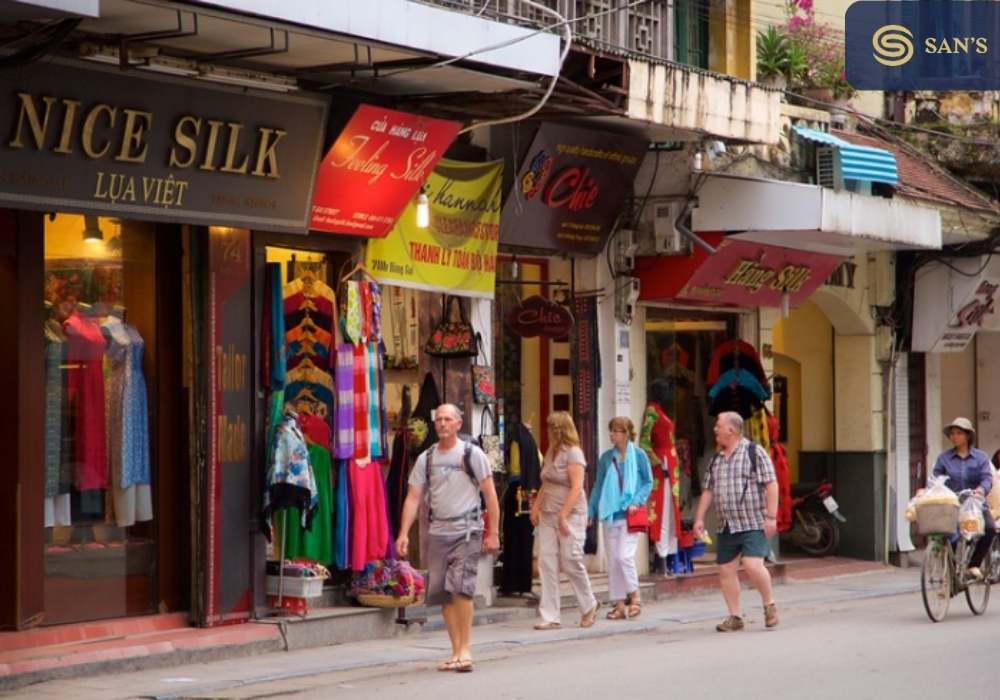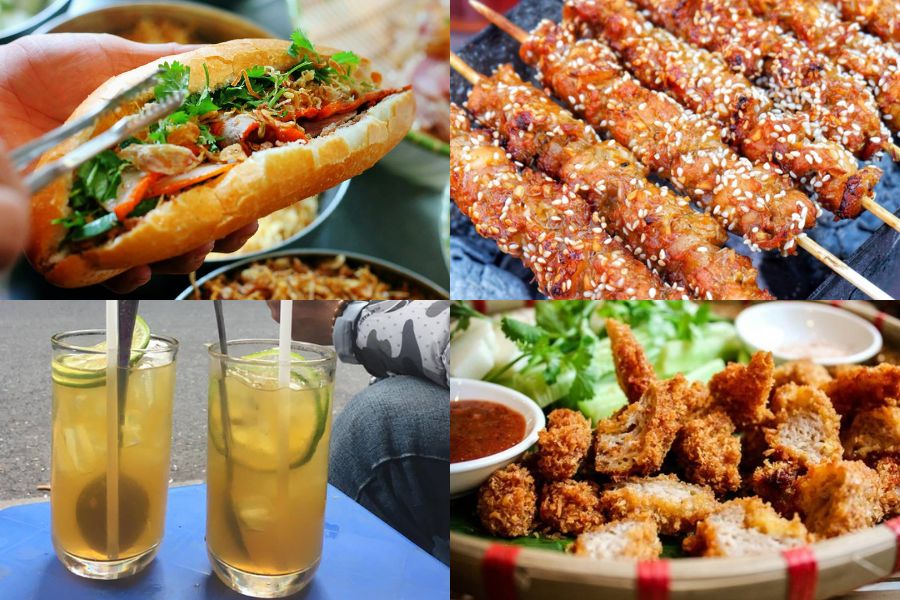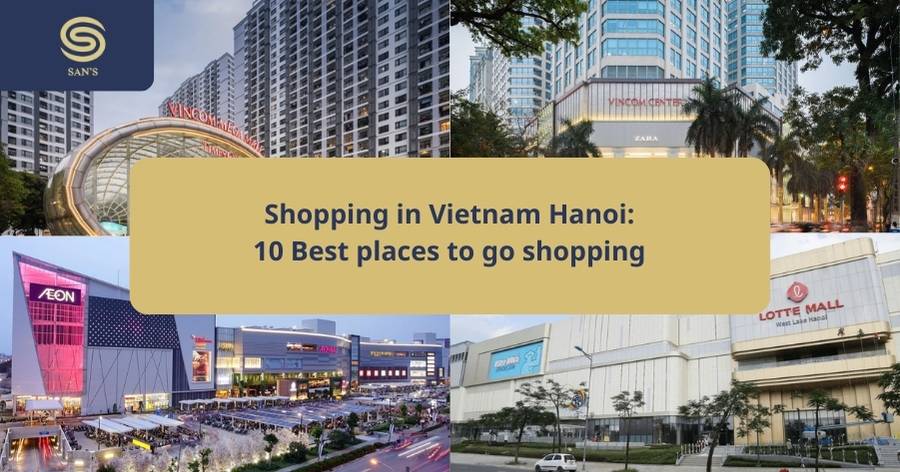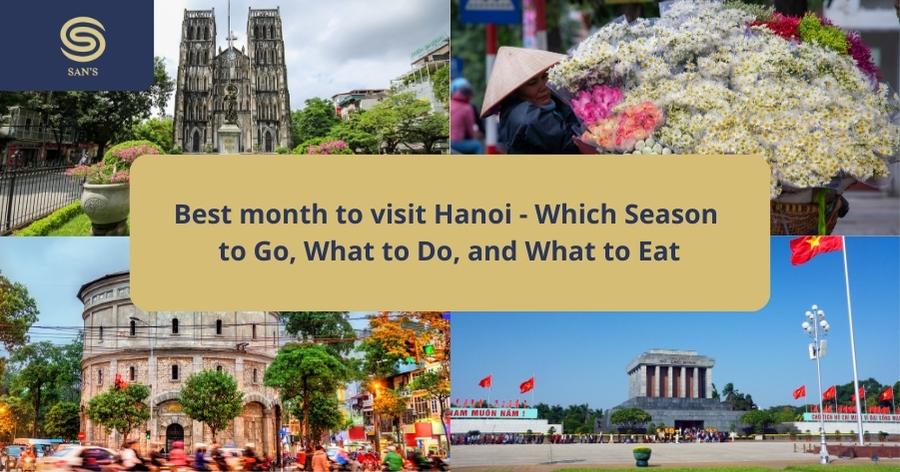Nestled amidst the historical labyrinth of Hanoi’s streets lies Hang Dao Street – not just another avenue, but a vibrant testimony to the city’s timeless spirit. Acting as a mirror reflecting Hanoi’s essence, Hang Dao is more than just a destination; it is an experience, a journey through time, and a celebration of Vietnamese heritage.
As we delve deeper into the folds of this article, we invite you to walk alongside us through Hang Dao Street, unraveling the tapestry of history, commerce, and culture that makes it the beating heart of Hanoi.
-

Hanoi Old Quarter
Historical Significance of Hang Dao Street
During the French colonial era, Hang Dao Street was known as Rue de la Soie, a testament to its prominence as a hub for silk trading. However, as Western tailor shops gained popularity over the years, the traditional silk merchants began to wane, paving the way for the street’s metamorphosis into a haven for luxury shopping—a legacy that stands strong today.
-

Shops selling silk fabrics line the street
Today, Hang Dao Street is not only the pulsating heart of Hanoi’s Old Quarter but also a bustling epicenter of fashion and retail. From stylish apparel and intricate jewelry to exquisite timepieces and footwear, the street brims with a plethora of stores catering to the evolving tastes of both locals and international visitors.
Things to do on Hang Dao Street
Things to see
Hang Dao Street isn’t just a bustling commercial hub or a lively weekend pedestrian zone; it’s also a treasure trove of historical landmarks. For instance, the Dong Lac Temple at 38 Hang Dao venerates the Thang Long Tu Tran – the revered Four Guardians of Thang Long.
Further down, at 51 Hang Dao, lies the residence of a lineage of painters, known for their unparalleled prowess in capturing human portraits. Astonishingly, even the most advanced digital tools pale in comparison to the craftsmanship of these traditional artists.
Since 2013, the nocturnal market stretching between Hang Ngang and Hang Dao has become an iconic nightlife spot. Every weekend, particularly on Friday, Saturday, and Sunday nights, the area buzzes with vendors, entertainers, and occasionally, artists, all contributing to a vibrant and festive ambiance.
-

City View building
What to eat
Wandering through the night market of Hang Ngang – Hang Dao, you’re enveloped in an enchanting ambiance, punctuated by the irresistible aromas of Hanoi’s signature street foods. It’s a gastronomic journey waiting to be undertaken.
Banh Mi: Dive into the quintessential flavors of Vietnam with a bite of the iconic “banh mi”. Filled with succulent grilled meat, crunchy cucumber, and aromatic local herbs, these sandwiches are a staple. And, the experience is made all the more authentic as vendors grill the meat and assemble your “banh mi” right in front of you.
Thit Xien Nuong: For meat aficionados looking to savor the essence of grilled delicacies, the “thit xien nuong” or grilled pork skewers are a must-try. Pocket-friendly, these delightful skewers range from 15000-20000 VND each.
Tra Chanh: As night falls, join the locals in the age-old tradition of sipping lemon tea. It’s not just a drink, but a cultural experience. Gather with your companions and immerse yourself in the vibrant night market scene, enjoying some people-watching as you sip.
Nem Chua Ran: Venture a bit more into the local flavors with the Vietnamese grilled fermented pork roll. Cooked over open charcoals, this dish is perfectly complemented with tangy fruits like star fruit, green mango, and cucumber, balancing its rich flavors.
Dive into the heart of Hanoi’s culinary scene and let your taste buds embark on an unforgettable journey.

Travel Tips for Visitors
1. Best Time of Year to Visit:
- Spring (March to April): During these months, Hanoi experiences pleasant weather, with mild temperatures and blooming flowers, making it a picturesque time to explore Hang Dao Street and the city at large.
- Autumn (September to November): This period is marked by cool breezes and a comfortable climate, perfect for strolling down the streets and indulging in outdoor activities.
2. Navigating the Street and Surrounding Areas:
- Walking: Hang Dao Street, especially during the weekends when it turns pedestrian, is best explored on foot. This allows visitors to fully immerse themselves in the street’s vibrant atmosphere and to discover hidden gems.
- Cyclo Rides: To experience Hanoi’s traditional mode of transportation and get a unique perspective of the area, consider hiring a cyclo. Ensure you agree on a price before starting your journey.
- Maps and Apps: While the charm of Hang Dao lies in its maze-like structure, it’s easy to get lost. Use maps or navigation apps like Google Maps or Maps.Me to guide you.
As our journey through Hang Dao Street draws to a close, we are reminded of its enduring allure—a bustling avenue that harmoniously weaves modernity with antiquity, commerce with culture. The street’s heartbeat resonates with tales of yesteryears, of traders and artisans, of festivals and daily life, creating a symphony that captivates both the casual visitor and the keen historian.
Yet, the charm of Hang Dao extends beyond its vibrant markets and historical landmarks. It lies in the spirit of its people, in the stories whispered by its ancient walls, and in the laughter and chatter that fills its air. Such places, rich in heritage and alive with contemporary vigor, are not just destinations but are living legacies.
In an ever-evolving world, it becomes paramount to cherish and safeguard such treasures. Hang Dao Street stands as a testament to Hanoi’s rich tapestry of history and culture, and it is up to us, the admirers and custodians of its charm, to ensure that its stories continue to be told, appreciated, and preserved for generations to come.
-

Hang Dao Street
FAQs about Hang Dao Street, Hanoi
1. Where is Hang Dao Street located in Hanoi?
- Hang Dao Street is centrally located in Hanoi’s Old Quarter, which is the city’s historic heart.
2. What can I expect to find on Hang Dao Street?
- Hang Dao is renowned for its shopping opportunities, especially clothing, accessories, and souvenirs. Moreover, there are numerous eateries, historical sites, and cultural attractions.
3. Is it safe to visit Hang Dao Street at night?
- Yes, Hang Dao Street is generally safe at night, especially during the weekend when it becomes a bustling pedestrian zone. However, as with any popular tourist spot, always be aware of your surroundings and keep personal belongings secure.
4. Can I access Hang Dao Street by car?
- On weekends, Hang Dao Street becomes a pedestrian-only zone in the evenings, so vehicles are restricted. However, during weekdays, cars can access the street, but it’s always crowded, and parking is limited.
5. Are there any must-visit attractions near Hang Dao Street?
- Yes! Nearby attractions include the Hoan Kiem Lake, the Night Market, and several temples and pagodas scattered throughout the Old Quarter.
6. What kind of street food can I try on Hang Dao Street?
- Hang Dao offers a variety of Vietnamese street foods, including “banh mi” (Vietnamese sandwich), “thit xien nuong” (grilled pork sticks), and “nem chua ran” (grilled fermented pork roll), among others.
7. Is it customary to bargain when shopping on Hang Dao Street?
- Yes, bargaining is a common practice in the markets and with street vendors. It’s recommended to negotiate prices politely to get a good deal.
8. Are credit cards widely accepted on Hang Dao Street?
- While some established shops might accept credit cards, many small vendors operate on a cash-only basis. It’s a good idea to have some Vietnamese Dong on hand.
9. Are there many accommodation options around Hang Dao Street?
- Around this street, within a 1-kilometer radius, there are many accommodation options ranging from basic to luxury, allowing you to choose a perfect place to stay for your trip. Depending on your budget, you can select from budget hostels to 3-star, 4-star, and 5-star hotels. To explore more hotel options, you can read further: “Top 10 Best 4-Star Hotels in Hanoi” to compare and make the best choice.





